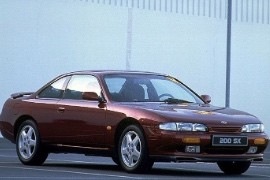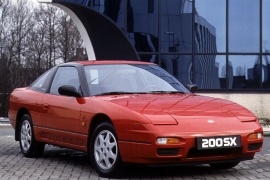NISSAN 200 SX Models/Series Timeline, Specifications & Photos
First production year: 1989
Engines: Gasoline
Body style: Coupé (two-door)
The 200SX was the export name for the Silvia S14, and it featured a few minor differences, but it kept the same handling package and a similar performance level.
Nissan Silvia nameplate goes back in time since 1975 when a small coupe with a fastback body was introduced. It wasn't even named Nissan, but Datsun. It made it to the export market and made it on the U.S. sol as well, in a time when the oil crisis crushed the muscle-car era. Fast forward to 1993, when the 1994 200SX was introduced on many markets, including the European and Australian ones.
The exterior was very similar to the Silvia S14 with rounded edges and no pop-up headlights, like its predecessor, the Nissan 280SX. It was offered exclusively as a three-box body shape coupe, while Nissan axed the production plans' fastback. Its wider track and longer wheelbase made the 200SX/Silvia S14 more comfortable.
Inside, it didn't show too much inspiration from the designers. It might have been mistaken with a Sentra or Maxima. Just a four-dials instrument cluster and a softly curved dashboard. The upper side was occupied by the HVAC on the center stack, which was sloped and not vertical while the audio system was placed on the bottom. Its front bucket seats promised good support while cornering. In the back, there was a place only for smaller people.
From a technical point of view, the 200SX was a different story. Even though it competed against other sport-coupe cars from its eras, such as the Honda Prelude, Mazda MX6, or Ford Probe, it offered a rear-wheel-drive platform that made it great for drifting. It was fitted as standard to a 5-speed manual, but a 4-speed automatic was available.
Also known as the Silvia S13, the fourth generation of this nameplate was launched by Nissan in 1989 and was sold under different names, depending on the market.
The late '80s brought a new rise in customers' demands for coupes and practical hatchbacks that could be used as a daily and sports cars as well. Nissan already had a good name in this segment with the previous three generations of the Silvia/SX series. But when it introduced the S13, it changed everything and created a legendary vehicle. The car's drift abilities were appreciated worldwide, and the chassis' balance was excellent. In addition, despite its small engines, they were peepy thanks to turbocharging technologies.
While the Silvia's third generation sported wedged shapes, the 1989 model came with shaved corners and curved surfaces. Still, the pop-up headlights were kept for most countries, while in others, these were replaced by fixed ones. Nissan made the S13 available in two body styles: hatchback and coupe. The former was the one that reached most markets. It featured a broad, sloped windscreen that also served as a hatch to access the trunk.
Inside, Nissan installed bolstered front bucket seats and a tiny bench profiled for two in the back. The low-mounted dashboard created excellent visibility for the driver. Its instrument cluster was minimalist and offered two wide dials for the speedometer and tachometer flanked on the outer sides by the fuel gauge on the left and water temperature on the right. On the sloped center stack, Nissan installed the HVAC controls at the top, followed by a tape player and a small storage area. The center console hosted the stick and the ashtray, while a second storage compartment, with a lid on top, also served as an armrest.
Under the hood, the automaker installed a 1.8-liter turbocharged inline-four with different power levels. Nissan also sold the car with a naturally-aspirated 2.4-liter engine under the 240SX badge. Power went to the rear via a five-speed manual or, as an option, a four-speed automatic.

